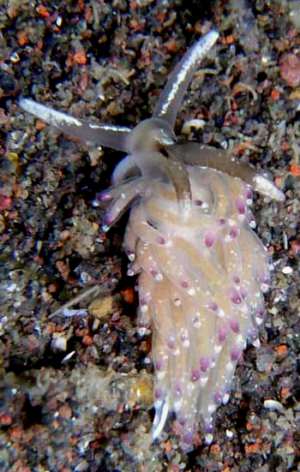
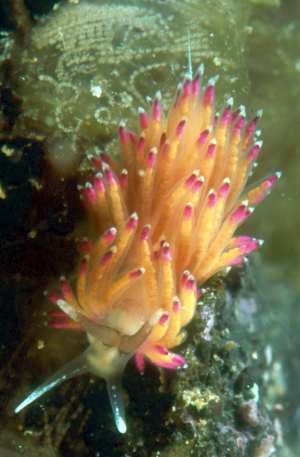
Favorinus pacificus
Baba, 1937
Order: NUDIBRANCHIA
Suborder: AEOLIDINA
Family: Glaucidae
DISTRIBUTION
Known from Japan and Sth Korea
PHOTO
Upper: Osezaki, Izu peninsula, Japan mainland. Depth: about 10 m. Length: 12 mm. unknown, March, 2004. sandy, shallow water. Photographer: Mr.Tomohiko Kurihara. Lower: Sasu Harbor, Jeju Island, Sth Korea. Depth: 5 m. Length: 8 mm. 27 June 2004. Sandy bottom with Rock .Photographer: Dong Jin Jwa
The following description is part of the original description from Baba (1937), based on a single specimen from Tomioka, Amakusa, Japan:
'[10 mm long alive] The antero-lateral corners of the head are continued out into two exceedingly slender oral tentacles. The rhinophores are a little shorter and cylindro-conical, with indistinct constrictions along the whole length. The margin of the back bears a small number of fusiform branchial papillae in 7 oblique rows ..... The foot is fairly narrow, passing off to a point behind. The front edge is rounded off and its corners are produced outward into tentaculiform processes.
The general colour of the body is translucent white and this is true of the oral tentacles, tail and foot. The rhinophores are chocolate tinted, except at the distal third which is colourless. The branchial papillae [cerata] are dark yellow almost up to the tip which terminates in a white cap, with a purple marking below. [Teeth without any sign of denticles].'
As I discuss in a separate message [#13616] the animals illustrated here are probably this species, but they differ in some aspects of Baba's description.
-
Baba, K. (1937} Opisthobranchia of Japan (II). Journal of the Department of Agriculture, Kyushu Imperial University, 5(7): 289-344
Rudman, W.B., 2005 (April 26) Favorinus pacificus Baba, 1937. [In] Sea Slug Forum. Australian Museum, Sydney. Available from http://www.seaslugforum.net/find/favopaci
Related messages
Re: Jun's Favorinus mirabilis ?
May 2, 2005
From: Jun Imamoto
Dear Bill and Atsushi,
I agree with Atsushi's comments [#13443].
The two animals I sent photos of were from the same aplysiid egg mass. I thought that the two individuals were the same when I sent my message but I agree with Atsushi's opinion that they are different. I appreciate the comments of Bill and Atsushi.
Best Regards,
Jun Imamoto
http://www.umiushi.info/
imamoto@umiushi.info
Imamoto, J., 2005 (May 2) Re: Jun's Favorinus mirabilis ?. [Message in] Sea Slug Forum. Australian Museum, Sydney. Available from http://www.seaslugforum.net/find/13695Dear Jun,
It's nice to see old puzzles being resolved
Best wishes,
Bill Rudman
Re: Jun's Favorinus mirabilis ?
April 29, 2005
From: Atsushi Ono
Dear Bill,
I saw Jun Imamoto message [#11813] about Favorinus mirabilis? from Japan. I think that the lower photograph is Favorinus japonicus and that upper one is F. pacificus. The rhinophore of F. pacificus looks in in general like a simple stick. Compared with the rhinophore in the lower photo which has a large swelling - and this swelling might become 2 or 3 as the animal grpws like in F. japonicus. I think the two are the same colour because they have been eating the same eggs.
Sincerely,
Atsushi Ono
ononini@cosmos.ne.jp
Ono, A., 2005 (Apr 29) Re: Jun's Favorinus mirabilis ? . [Message in] Sea Slug Forum. Australian Museum, Sydney. Available from http://www.seaslugforum.net/find/13443Dear Atsushi,
Jun's message suggested that the photos were of the same animal but your interpretation certainly make more sense. I'll move the message to the F. pacificus page.
Best wishes,
Bill Rudman
Favorinus pacificus in Japan
April 27, 2005
From: Rie Nakano

Dear Dr.Rudman,
Here is a photo of Favorinus pacificus Baba, 1937 taken by Mr. Tomohiko Kurihara.
Locality: Osezaki, Izu peninsula, Japan mainland. Depth: about 10 m. Length: 12 mm. unknown, March, 2004. sandy, shallow water. Photographer: Mr.Tomohiko Kurihara
Sincerely,
Rie Nakano
rie@divers.ne.jp
Nakano, R., 2005 (Apr 27) Favorinus pacificus in Japan. [Message in] Sea Slug Forum. Australian Museum, Sydney. Available from http://www.seaslugforum.net/find/13535Dear Rie,
Thanks for this interesting photo. It certainly fits the original description of Favorinus pacificus, which was based on a single specimen, quite well, but as I discuss separately [message #13616 ], there are still some puzzles surrounding just what this species is. It may be it has variations in colour and rhinophore shape, or it may be we are dealing with more than one species.
Best wishes,
Bill Rudman
Identifying Favorinus pacificus
April 27, 2005
From: Bill Rudman
A number of recent messages have raised the identity of Favorinus pacificus. Although I have discussed most of the following points while discussing those messages it is probably worthwhile to summarise them all into a single message. Favorinus pacificus, was unfortunately based on a single specimen, which means that no matter how good the description was, it gives us no idea of variability within the species - does it chnage with size? is its colour pattern variable? do the rhinophores vary in degree of lamellation etc?.
Photos posted by Rie Nakano [#13535] and Dong Bum Koh [#13627] both fit many aspects of Baba's original description but they are not 'perfect fits' . For example, Baba described the cerata as being arranged in 'oblique rows' and yet if you look at Koh's photo, the first 3 rows of cerata are clearly in arches. You will see 3 pinkish arches on the left side of the animal. What has happened here is that the animal has dropped the cerata [autotomy] from these 3 rows - perhaps through being handled. Another point is that Rie Nakano's photo, and Koh's, show a white tip to the oral tentacles and a white line continuing down towards the base. Baba does not mention any colour on the oral tentacles.
In Atsushi Ono's 1999 book (Photo 276, p.164) there is a Favorinus sp. which also fits Baba's description quite well, but that animal has translucent yellowish oral tentacles, with no trace of white, and has a yellow median line on the head between the rhinophores. Since these features were not described by Baba could this animal be the real Favorinus pacificus? In a recent message from Singapore [#13607], Lim Han Peng has posted a photo of an animal very much like Atsushi Ono's, with a yellow line between the rhinophores. The cerata are pinkish rather than yellow, but that colour is due to the colour of the eggs they have been eating so is variable. The Singapore animal has much more pronounced lamellae on the rhinophores than your animal, but that suggests the degree of lamellae development is variable. Some animals indentified as Favorinus mirabilis [see Scott Johnson's message #1639] have a yellow median line. Does this mean that F. mirabilis has variable development of the rhinophore lamellation?
This brings up the question of Favorinus mirabilis, which as I have discussed separately, is probably two species? The 'form' I have called Favorinus cf mirabilis seems to me to fit Baba's description of Favorinus pacificus, at least on external features, extremely well. They have brownish rhinopores, bright yellow cerata with a white cap and a purple mark below. The only difference is the lamellae on the rhinophores. Can Baba's description 'indistinct constrictions' fit? Again the problem of not knowing how variable these characters are in each 'species' makes interpretation impossible.
What we definitely need is more information on all these 'forms' or 'species'. In the meantime I will tentatively identify Rie Nakano's and Dong Bum Koh's animals on the Forum as Favorinus pacificus.
Best wishes,
Bill Rudman
Koh's aeolid is Favorinus pacificus
April 27, 2005
From: Atsushi Ono
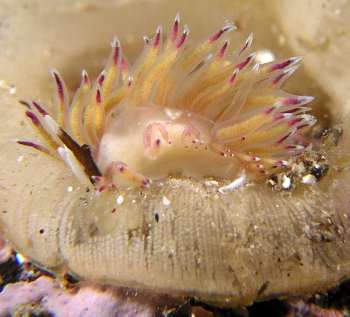
Dear Bill.
I think that Koh's aeolid [#13627] is Favorinus pacificus Baba,1937. If the
rhinophore can be seen close-up, indistinct constrictions along the whole
length can be seen. [copy of Koh's photo alongside ]
Sincerely,
Atsushi Ono
ononini@cosmos.ne.jp
Ono, A., 2005 (Apr 27) Koh's aeolid is Favorinus pacificus . [Message in] Sea Slug Forum. Australian Museum, Sydney. Available from http://www.seaslugforum.net/find/13647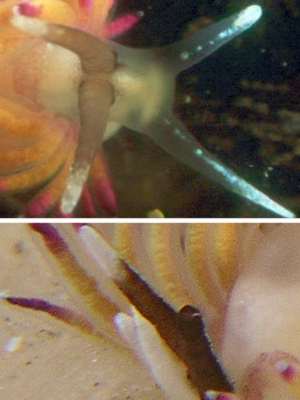
Dear Atsushi,
Thanks very much for you suggestion. As with Rie Nakano's message [#13535], it is helpful in illustrating the problems I have in identifying Favorinus japonicus, a species which was unfortunately based on a single specimen. I have discussed this more fully in a separate message [#13616]. I have included close-ups of the rhinophores from Koh's earlier photos and they show little sign of lamellae or even constrictions but this could be dependent on how extended the rhinophores are are any one time.
One example of the problems is that Baba described the cerata as being arranged in 'oblique rows' and yet if you look at Koh's photo, the first 3 rows of cerata are clearly in arches. You will see 3 pinkish arches on the left side of the animal. What has happened here is that the animal has dropped the cerata [autotomy] from these 3 rows - perhaps through being handled. Another point is that Rie Nakano's photo, and Koh's show a white tip to the oral tentacles and a white line continuing down towards the base. Baba does not mention any colour on the oral tentacles. However in your 1999 book (Photo 276, p.164) you have a Favorinus sp. which also fits Baba's description quite well, but that animal has translucent yellowish oral tentacles, with no trace of white, and has a yellow median line on the head between the rhinophores. Since these features were not described by Baba could this animal be the real Favorinus pacificus?
In a recent message from Singapore [#13607], Lim Han Peng has posted a photo of an animal very much like the one on your book, with a yellow line between the rhinophores. The cerata are pinkish rather than yellow, but that colour is due to the colour of the eggs they have been eating so is variable. The Singapore animal has much more pronounced lamellae on the rhinophores than your animal, but that suggests the degree of lamellae development is variable.
This brings up the question of Favorinus mirabilis, which I have discussed separately, is it one or two species?
Best wishes,
Bill Rudman
Another photo of Favorinus
April 27, 2005
From: Dong Bum Koh
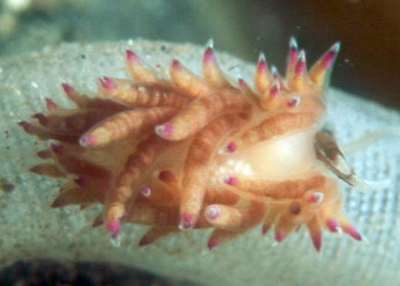
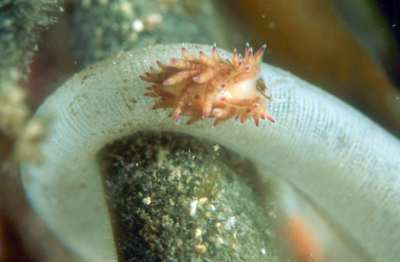
Dear Bill,
To accompany my earlier message [#13627], here is another photo of Favorinus on Pleurobranchaea cf japonicus eggs. Photographer: Youn Byung Ro.
Dong Bum Koh
drkoh@seasee.co.kr
D. B. Koh, 2005 (Apr 27) Another photo of Favorinus. [Message in] Sea Slug Forum. Australian Museum, Sydney. Available from http://www.seaslugforum.net/find/13653Dear Koh,
Thanks for this photo. As you will see in today's messages [see #13616], this could well be Favorinus pacificus, a species not recorded since its original description in 1937.
Best wishes,
Bill Rudman
Favorinus mirabilis? from Sth Korea
April 25, 2005
From: Dong Bum Koh
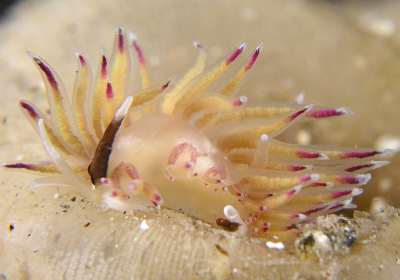

Dear Bill,
Here are some photos of Favorinus mirabilis from Jeju Island, Sth Korea.
We found this animal eating eggs of Pleurobranchaea japonica [see message #13628] at night.
Locality: Sasu Harbor, Jeju Island, Sth Korea. Depth: 5 m. Length: 8 mm. 27 June 2004. Sandy bottom with Rock .Photographer: Dong Jin Jwa
Best regards,
Dong Bum Koh
drkoh@seasee.co.kr
Koh, D. B. , 2005 (Apr 25) Favorinus mirabilis? from Sth Korea. [Message in] Sea Slug Forum. Australian Museum, Sydney. Available from http://www.seaslugforum.net/find/13627
Dear Koh,
Thanks for these wonderful photos of Favorinus eating the eggs of Pleurobranchaea. However if this is Favorinus mirabilis, I am very puzzled by the shape of the rhinophores and the colour pattern. In particular, the rhinophores of F. mirabilis are not smooth and tapering, as in your photos, but large and lamellate. Also the oral tentacles in F. mirabilis are uniformly coloured, typically with yellow pigmentation. Your animal is very similar to those in Jun Imamoto's message [#11813] both in rhinophore shape and colour of the oral tentacles, so perhaps there is more than one species being confused here.
Best wishes,
Bill Rudman
Re: Favorinus mirabilis? from Japan.
January 10, 2004
From: Jun Imamoto
Dear Bill,
Thank you for your comment on my photo. It will be interesting to find out if the rhinophore shape does change as the animal grows. It does seem to be a big change. If I am lucky enough to see the shape chnage as the animals grows I will let you know.
Best Regards,
Jun Imamoto
http://www.umiushi.info/
imamoto@umiushi.info
Imamoto, J., 2004 (Jan 10) Re: Favorinus mirabilis? from Japan.. [Message in] Sea Slug Forum. Australian Museum, Sydney. Available from http://www.seaslugforum.net/find/11864Thanks Jun,
I know it seems a major change in rhinophore shape but in juvenile aeolids the rhinophores always start out as a simple smooth rod. Only as they grow to the rhinophore begin to elaborate and grow lamellae, or papillae, or swelling. I could be quite wrong in this case but I suspect the only way we will find out is if we can get information on whether it changes shape as it grows. Unfotunately the radula does not seem to be a good character to use in this genus, in some species it seems that the denticles can be present or absent, and in sometimes different species can have almost identically shaped radular teeth
Best wishes
Bill Rudman
Favorinus mirabilis? from Japan.
January 9, 2004
From: Jun Imamoto
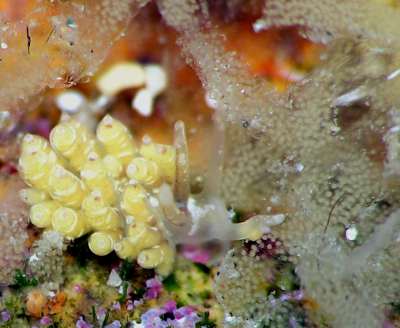
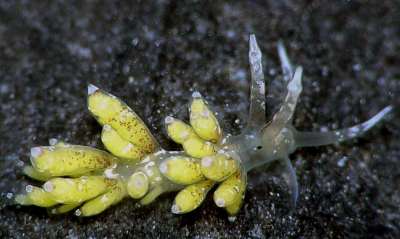
Dear Bill,
Here is another sea slug which I have not seen before. It was eating the eggs of Aplysia. I am happy if these reports are useful for your research.
4 January 2004
Amami Ooshima Islands, Kagoshima, Japan.
Size: approx 6mm
depth: 1 m
temperature: 22 C
Best Regards,
Jun Imamoto
imamoto@umiushi.info
Imamoto, J., 2004 (Jan 9) Favorinus mirabilis? from Japan.. [Message in] Sea Slug Forum. Australian Museum, Sydney. Available from http://www.seaslugforum.net/find/11813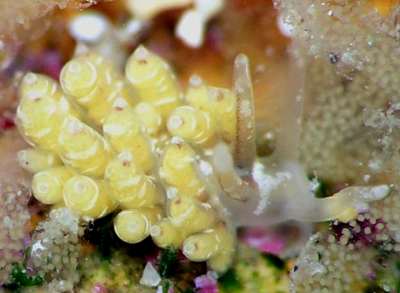
[Note added 29 April 2005: see message #13443 suggesting upper photo is F. pacificus and lower F. japonicus]
Dear Jun,
From the conspicuous purplish spot near the tip of each ceras I would say this animal is Favorinus mirabilis but the shape of the rhinophores is a bit of a puzzle. In Favorinus mirabilis the rhinophore clubs are lamellate, while in your animal they are smooth except for a subterminal swelling which is obvious in the photo of the animal crawling on the rock. At 6mm, this is clearly a juvenile so perhaps it has not yet developed lamellae. It would be good if you could find some slightly larger animals so we could see if lamellae develop on the rhinophores at a later stage in their development
Best wishes
Bill Rudman
